Dispatch 3
Date: June 14, 2001 Thursday
Location: Beijing
We know it seems like we’re going like crazy and trying to touch every tourist thing possible, and in fact we are. These are the last few days that we will be able to go at this kind of pace, which is the pace that we’ve always gone at both when we travel and when we’re at home. In just two more days we will meet Eleanor, and our lives will speed up in some ways but slow down in others. We’re running full-steam-ahead until the time when we know we’ll have to shift our priorities in ways we can only imagine, to accommodate a young one.
Once again, the intrepid travelers got up and out early on foot after tanking up on hotel food at the breakfast buffet (burp). Today, we made our way west through the backstreets and neighborhoods of Beijing, the goal being the Beijing Zoo. The scene below was a typical one: bikes everywhere, with cars, bikes, and pedestrians competing for the road in a dangerous and noisy mix of vehicles and people. We were soon the only Westerners in sight–at least, the only ones not in a vehicle.
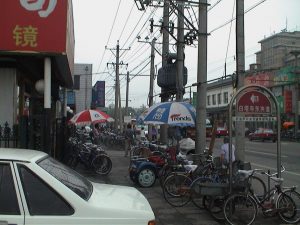
This time out, the landscape of Beijing came into a different focus for us. Moving west away from the tourist area, with its stark contrast between the tall shining hotels and the grimy, insular hutongs at their feet, we found ourselves in the midst of much more modern, well-kept apartment, office, and government buildings. Off the main roads, the one-story hutongs still spread out, but the lanes were much wider and it felt less intrusive to venture down them (though we were the objects of considerable curiosity). Is it “clean”? We’re still working out how to describe it: There is NO human litter–not even cigarette butts from the many smokers–either on the big streets or in the saddest hutong. There are, however, concentrated heaps of specifically raw vegetable foodstuff (husks, leaves, ends–the kind of thing you’d compost, if you had room) and of the detritus of once-useful objects that seem to have been picked over again and again, until there’s nothing left to salvage. No loose newspaper, no candy wrappers, no old clothes. No Styrofoam. No cardboard. It’s as though the clutter has less to do with personal messiness than with municipal poverty, probably insufficient funding to provide good garbage disposal.
Out of the blue, we stumbled on an ancient Buddhist site.
It was not well marked, comprising a series of now-familiar pagoda-like temple buildings seeming to lead up to a large, oddly shaped white structure–a striking color in this city where important things are mostly the lucky color, red (and the color of grief and death is white). We’d seen one of these things sticking up above the trees at a distance, nearer the Forbidden City, and wondered what it was. The white structure was, we learned, a Stupa–and this was no ordinary Stupa, but the largest and oldest left in the world, sited and laid out by Kubla Khan himself in 1271. As is typical with every public attraction in Beijing, there was a small army of staffmembers to sit and wait all day for a few visitors (Chinese worshipers, by the look of it) to come by. One person to sell the ticket for 5 yuan ($0.62), another standing by to punch or accept or tear the ticket, another to point you in the right direction. We saw this over and over again. It keeps people employed, I suppose.
Photographs were not permitted in most places within the temple. This was clearly an active place of worship. However, there was lots of opportunity to interact with the attendants, who seemed very interested in why we had come. We gave them our card explaining that we have come to China to adopt a little girl, and they responded enthusiastically, insisting that we accept laminated pictures of various of the myriad of statues, even writing out in Chinese notes that we will want to get translated as soon as possible.
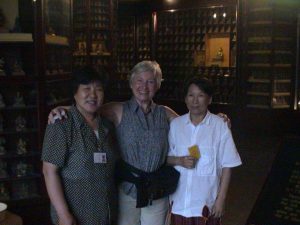
It’s hard to describe the shape of the stupa. Suffice it to say that every strange feature was, we learned, dictated by Buddhist cosmology: the numbers of realms, or wheels of reality, the shape of an inverted begging bowl, and so forth. Bottom line was, large and imposing as it was, it served solely as a repository for sacred texts (stored in the hat-like top of it), not to house human worship activities, which were the province of the surrounding temples. Interesting to us, too, was that this was one of the few places in Beijing where the government trotted out the usual “and this site has been designated as an important cultural treasure” without the usual accompaniment, “and it would have been even grander had those eight Allied powers not looted Beijing in 1910.”
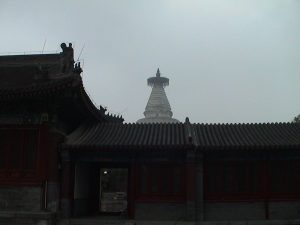
Ever onwards, we continued walking through the surrounding hutong and came across a relic of the Cold War: the former residence of Lu Sin (1887-1936), described as the Father of Modern Chinese Literature. We didn’t so much see his home as the airy modern museum (circa 1965) that replaced the home with two floors of photographs, text, and memorabilia of this important revolutionary novelist, essayist, and political philosopher (whom we’d never heard of before): Lu Sin rubbing elbows with Mao and Stalin, Lu Sin as the literary heir of Kierkegaard and Darwin, the colleague of Walt Whitman. How’d this guy get past us before this?
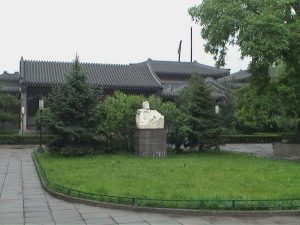
After the museum stop, we were damp from the steady drizzle and a little hungry from the activity. Diving deeper into the hutong, which in this case was looking much more like a village, we managed to find a stall that offered umbrellas and those enormous, tent-like ponchos we saw on many bike riders. Negotiations were brief, as we were standing in the rain while trying to argue down the price. Note to self: this is not a strong position to argue from.
About the hunger: just a few stalls over two boys and a young girl were selling rice pancakes of all sorts. Sitting on top was a beautiful one with scallions; our handy-dandy Bob Crawford phrase cards confirmed that it was “vegetarian.” We lost our senses, or perhaps we got lost IN our senses, bought two pieces for 2 yuan and hopped off. Almost immediately, however, we realized that we had broken our own rule not to buy street food. The intermittent smell of the sewer brought us back to reality. The food was surely good-tasting–and this is a kind of food we’ve frequently bought from street vendors in New York’s Chinatown–but not for travelers who didn’t have time to get accustomed to the local germs. Disappointed, we stowed the pancakes for the next beggar (who devoured them immediately). Packaged ice cream would have to do, and we soon found some.
At long last, we approached where we thought the Beijing Zoo should be–but where was it? We’d been walking for several hours, not counting the time spent meandering through the temple and museum. We thought of the taxi driver from the previous day, who had scoffed at our confidence that we could go the distance to the zoo on foot. We’d certainly showed him, all right, but our feet were complaining.
At one particularly confusing intersection, where construction barriers made it impossible to figure out what way to proceed, Robert impulsively hailed a bicycle rickshaw, and we were off for the ride of our lives! Wait until you see the video of the view from the back seat as we careen through traffic at odd angles and breakneck speed!
We went through thick mud and at one point had to get out and help the driver push. We were delivered to the gate of the zoo, though, safe and laughing hysterically. We never would have found it otherwise. Our wiry, but obviously powerful driver was so good-humored and friendly,and worked so industriously for his pay, that Robert added two Sacajewea (sp?) American dollars to the 20 yuan price (about $2.75). As we parted, we noticed that a small knot of onlookers had gathered around him; everybody wanted to see this novel money, which at first not even he had recognized as legitimate American currency.
At the zoo, we found — you guessed it — a Giant Panda exhibit.
The zoo was very nice and very modern in some parts, very old-style prison exhibit in other parts. It looks like they’re making great strides at improving the entire park, however, though you’d surmise that zoo improvement is hardly a big priority for the Chinese, with so many other pressing social problems to solve. The turtles are just going to have to wait for their turn at a renovated exhibit hall. We highly recommend a trip to the Beijing Zoo if you have the time. Particularly their collection of herons, storks, and other waterfowl. Here’s the obligatory picture of the beloved panda.
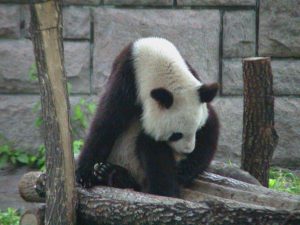
One particularly nice novelty (for us) about the Beijing Zoo is that the hoofed animals are allowed to come right to their enclosure perimeter and stick their noses through hoping for a snack and a scratch–and are obviously accustomed to interacting with visitors. This kind of zoo-keeping probably reflects a Chinese cultural choice: the deer is the symbol of peace. Great fun, but yet another reason to bring along hand sanitizer.
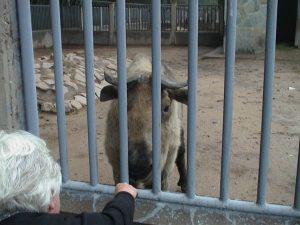
After the zoo, we sought out the nearest station of the Beijing Subway and took it for a spin. It was incredibly clean (no litter at all, and no garbage), quiet, and fast, though not particularly modern looking. We went around to the opposite side of the city looking for an ancient earthquake detector that we had seen pictures of, year ago. We didn’t find the earthquake sensor, but we did come across an ancient observatory that we realized we’d also heard about. It had long since closed by the time we got there, so we left it for the next day’s adventure.
Walk, walk, walk, and walk some more to get back to the hotel, ending in some frank trudging. Finally, the hotel, like an oasis of comfort! Unwilling to pay hotel prices for food, etc., we bought a few cans of local Beijing beer for 3 yuan each (about 37.5 cents) and a packaged bucket of ramen noodles. This, combined with the leftovers from the restaurant of the night before, made for dinner for two very tired and footsore tourists.
Tomorrow, Tiananmen Square, the Temple of Heaven, and that ancient observatory–plus a filmed interview with an intern from CNN Beijing, who’s making a student documentary about people adopting from China.
Bye for now. Eleanor joins us in 3 more days!
Robert & Susannah / http://eleanorjean.com